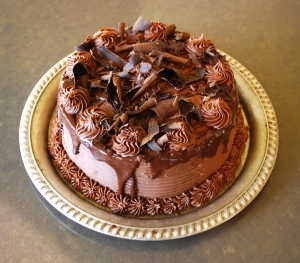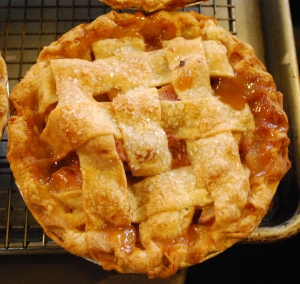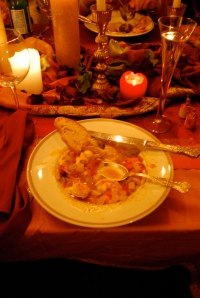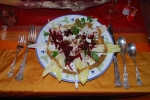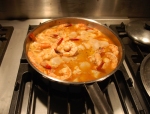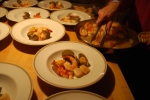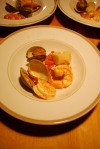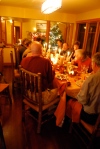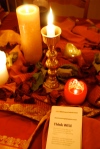 We’re just back from our delightful first trip to the beautiful Caribbean island of St. Maarten (Dutch side) / St. Martin (French side). The island has a fascinating history of countries vying for ownership of this small chunk of land, with these two winning out. As far as we could tell, delicious food was available on both sides, with French cuisine shining brightly at a higher price (the Euro was about 1.4 to our dollar).
We’re just back from our delightful first trip to the beautiful Caribbean island of St. Maarten (Dutch side) / St. Martin (French side). The island has a fascinating history of countries vying for ownership of this small chunk of land, with these two winning out. As far as we could tell, delicious food was available on both sides, with French cuisine shining brightly at a higher price (the Euro was about 1.4 to our dollar).
 We sampled a variety of food from totally “down-home grilled on the edge of the sea” bbq at Lolo’s in Marigot to a very sophisticated haute cuisine seafood sampler at Le Pressoir in Grand Case. However on our last night we enjoyed our favorite and oh so simply delicious meal in Marigot: steamed mussels in white wine!
We sampled a variety of food from totally “down-home grilled on the edge of the sea” bbq at Lolo’s in Marigot to a very sophisticated haute cuisine seafood sampler at Le Pressoir in Grand Case. However on our last night we enjoyed our favorite and oh so simply delicious meal in Marigot: steamed mussels in white wine!
 This reminded us of how PERFECT this dish is. And of course we had it on our menu at Blue Mountain Bistro for years as Moules Marseillaise (recipe included below). As we happily dined on the tender, delicious mussels in the simply flavorful broth, we mused about these humble mollusks and Richard reminisced:
This reminded us of how PERFECT this dish is. And of course we had it on our menu at Blue Mountain Bistro for years as Moules Marseillaise (recipe included below). As we happily dined on the tender, delicious mussels in the simply flavorful broth, we mused about these humble mollusks and Richard reminisced:
 “I think I would rather have a nice bowl of steamed mussels than lobster. The broth that comes from steaming them in a bit of white wine, bay leaves and a hint of lemon juice is just heavenly. So heavenly in fact that ‘back in the day’ in France, they were frequently cooked for their broth only, to be used for seafood sauces and stocks. Their sweet heady aroma is simple but complex, earthy but from the sea, in short just about perfect. I picked some off the rocks near Montauk for Mary Anne on one of our first dates. (Did I mention they’re sexy also!!) She was quite impressed when I brought them home and steamed them with this same simple preparation, and that just about sealed the deal. We were engaged a few months later!”
“I think I would rather have a nice bowl of steamed mussels than lobster. The broth that comes from steaming them in a bit of white wine, bay leaves and a hint of lemon juice is just heavenly. So heavenly in fact that ‘back in the day’ in France, they were frequently cooked for their broth only, to be used for seafood sauces and stocks. Their sweet heady aroma is simple but complex, earthy but from the sea, in short just about perfect. I picked some off the rocks near Montauk for Mary Anne on one of our first dates. (Did I mention they’re sexy also!!) She was quite impressed when I brought them home and steamed them with this same simple preparation, and that just about sealed the deal. We were engaged a few months later!”
 Moules Marseillaise
Moules Marseillaise
by Richard Erickson, Chef-owner
Bistro-to-Go, Kingston, NY
10 lbs mussels
1/2 cup minced onion
1/2 cup minced fresh fennel
1/2 cup minced celery
1/2 cup minced leek
1/4 cup olive oil
1/2 cup chopped garlic
4 T minced shallot
Red pepper flakes to taste
1 t crushed fennel seeds
Pinch saffron
2 cups white wine
Butter
Chopped tomato
Juice of 1 lemon
Fresh herbs (preferably mixture of parsley, chives and tarragon or dill)
1. Slowly cook onion, leek, fennel, and celery in olive oil until soft but not brown.
2. Add garlic, shallot, red pepper flakes, fennel seeds, saffron, white wine and simmer for ten minutes. Reserve this mixture. (It keeps well in the refrigerator for 3-4 days)
3. For each serving of mussels add 2 heaping tablespoons of the mix and 1/3 cup of wine, 1 tablespoon butter, 1 tablespoon lemon juice, 2 tablespoons chopped tomato, and a pinch of the mixed herbs.
4. Cover and steam until the mussels open.
Serve in bowls with the accompanying liquid and crusty French bread.
12 large servings / Enjoy!!!





